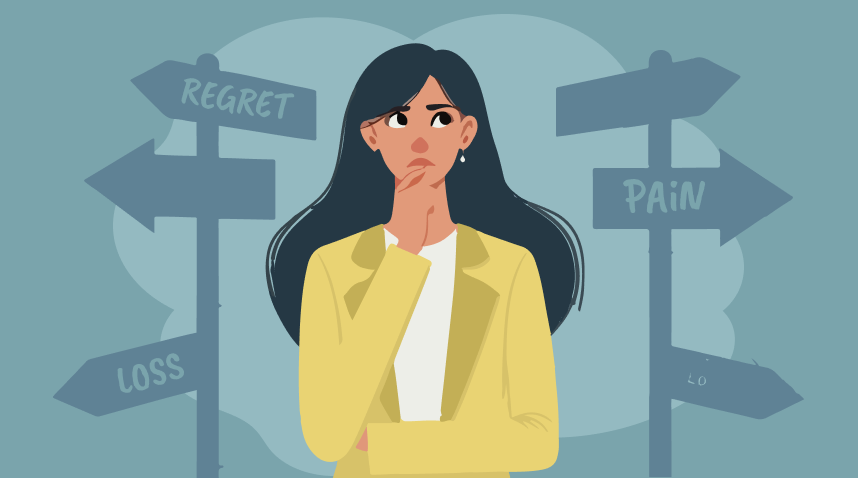TLDR: Having uncovered the ‘lies’ of happiness in Part I, we now explore how we can choose our Dukkha wisely as lay people.
So… How to Choose Our Dukkha Wisely??
While dukkha is an inherent truth of life (first noble truth), the Buddha shared that there is a solution to it (third noble truth), and the solution is living by the Noble Eightfold Path (fourth noble truth).
This involves:
1. Right View
2. Right Intention
3. Right Speech
4. Right Action
5. Right Concentration
6. Right Mindfulness
7. Right Livelihood
8. Right Effort
In particular, “choosing our dukkha wisely” would first involve developing the Right View.
An example to illustrate this point…
For someone trying to develop a healthy lifestyle…
Compare the 2 scenarios:
A person decides to eat lots of junk food for supper because he/she feels like it despite setting the goal to be healthier. Thereafter, he/she skips arm and leg days at the gym… AND THEN the next day, suffer from a sore throat, heaviness in the body, and eventually falling sick, developing pimples, looking into the mirror regretfully, feeling guilt and self-loathe…,
VS
A person decides to suffer the pain of delayed gratification, feel the burn for the next 3 days from hitting the gym, training him/herself to have the discipline to resist temptations… BUT, the result is a healthier body, feeling more energised, being proud of him/herself for persevering through, and having more focus in the day.
This is a distinction between someone unaware and inevitably causes themselves more suffering due to a wrong view, versus someone who is aware and chooses short-term suffering in exchange for long-term gains…
(p.s. Both experiences above described me… trust me the first scenario never ends well… hahaha)
While we can’t always maximise pleasure and there will be pain and suffering to some degree in our lives, we can choose to make decisions that honour our long-term values. These decisions should help us develop wholesome qualities in the long run, which will guide us towards the trajectory of awakening.
Ways to Develop the Right View:
According to the Buddha, it’s about first upholding “sila” (ethics) through the 5 precepts. It’s about actively choosing not to cause harm to self, to others, and helping those around us. Borrowing concepts from the therapeutic world, it’s also about choosing to act according to our values. It’s about equipping ourselves with Dhamma knowledge, so we can apply it in our lives to overcome moha (delusion) and reduce ignorance.
When we experience agitation in our minds, we need to start asking ourselves, “Why am I unhappy? What is it that I want?”, “Is this craving something I should let go of because it’s not going to bring me lasting happiness?”, OR “Is it a craving that will remain but I can choose to release the grip I have on it?”
Something I realised during the retreat is that…
As humans, we all have cravings. It is the nature of our minds and the human existence. And as we start to see how these cravings bring about unrealistic expectations and suffering, we should also refrain from blaming and faulting ourselves.
We need to forgive ourselves for what we may have done in the past which we now realise is due to these cravings and strive to do better.
How to Handle Strong Emotions During Our Practice?

As Dhamma practitioners, attempting to apply the Dhamma concepts to our lives and making sense of it may bring up emotions of discomfort. This is natural as we align our behaviours and thoughts more closely to the Dhamma and decide to act “against” our instincts that have been so entrenched and deeply rooted in us.
During the discussions of how to handle strong emotions (i.e. fear, guilt, remorse) when these come up during our sits, Sis Sylvia and co-teacher Bro Chye Chye shared the following pointers:
1. Observe the sensations that arise. Stay curious and open, but also focus long enough to observe the falling of those sensations and thoughts.
2. If the feelings/sensations don’t fall, end the sit and investigate the mental state. Prompting questions could be “What is this fear about?”, “What is it that I want? What is causing this feeling?”
I learnt that the Dhamma practice is about being patient and developing that mental resilience and discipline to stay with discomfort. It is about investigating our mental states to develop wisdom while being gentle with ourselves. It is also about reminding ourselves that we are worthy practitioners as long as we have chosen to practice this path, regardless of how early or late we have started.
“Be Light, Be Joyous”

This was a piece of advice inferred from my experience at the retreat, both from listening to Sis Sylvia’s sharing and also from observing how Dhamma practitioners carry themselves.
This advice not only applies to practising the Dhamma but also describes the attitude we should strive for in life.
As I learn the Dhamma from more people and understand the teachings more deeply, I grow to appreciate how lucky I am to chance upon this at an early age, and in this lifetime.
I have always wondered why there seems to be so much suffering in this world, and yet so much goodness that people have in them. This duality makes me ponder and wonder which side I am on. Maybe it’s part of the quarter-life crisis creeping up on me…Haha.
But something I realise through moments of reflection is that…we have seeds of both the wholesome and the unwholesome. We all experience dukkha in its form, we have cravings, and at some point in our lives, we start to seek answers. There is a part of us that seeks to do better while struggling to do so.
Perhaps this is what it means to be a human.
To struggle, and yet, to continue trying.
To try, and to try once more.
And amidst the trying, we find solace once we can start to see things for what it is.
We realise what is truly important to us.
We start to have more clarity and choose to let go of things that no longer serve us.
We realise that the pain we feel in our hearts is also felt by others as they, too, experience suffering.
And from this understanding, we start to develop true compassion for ourselves and others.
We strive to see everyone as equals because we realise that despite our different forms, we are the same.
And perhaps, that’s when metta and equanimity truly emerge.
Amidst the heaviness that sometimes accompanies life, I realise that the right understanding of the Dhamma also leads to joy and lightness that comes from knowing there is a way out of these needless sufferings. That we can equip ourselves with the right knowledge and mindset to “choose our dukkha wisely”.
The most experienced practitioners are those who can deliver the Dhamma in the most light-hearted yet profound manner (think: Venerable Thubten Chodron, Yongey Mingyur Rinpoche). Through them leading by example, I know that learning and practising the Dhamma is truly a joyous path to be on.
Gratitude for the Right Conditions
As I reflect on all the conditions that have led me to the retreat, I can’t help but feel a strong sense of gratitude and mudita (appreciative joy), seeing fellow kalyāṇamitta on this journey.
I am also deeply inspired by Sis Sylvia Bay and Bro Chye who showed us how learning and practising the Dhamma can bring such joy and lightness to one’s heart.
How understanding the Dhamma deeply, applying the Dhamma in our own lives, and developing faith in the Buddha and his teachings, can bring such confidence and clarity to one’s life as a lay practitioner.
And perhaps, this is truly the beauty of the Dhamma.
Even though the Buddha existed more than 2500 years ago, his teachings remain relevant. The closest we can ever get to know the Buddha is probably through the Suttas.
At the same time, he also told us not to blindly believe in what he says but to test it out through direct experience so that we can arrive at our own conclusion… Also known as “Ehi-Passiko“, one of my favourite Pali words.
My final thoughts:
I am starting to realise that… learning and applying the Dhamma is not for the faint-hearted. It’s for those with the courage to pursue the truth, dissect it, and investigate the mind.
This requires the humility to admit that we don’t always know the most, that we are not always right, and to put in the diligence to develop the mental alertness and mindfulness required to verify the Dhamma with our own lived experiences.
It is a process of cultivating the right view, seeking refuge in the Triple Gems (Buddha, Dhamma, Sangha) when we feel lost, and trusting that the practice will guide us towards clarity and inner happiness.
With wisdom comes the lightness of the heart. The ability to see reality for what it is is a journey in itself. One that probably never ends as long as our search for the truth never ceases.
And once the ego stops resisting,
We surrender, enjoy, and trust the unfolding,
And watch the awakening of the Bodhicitta within us…
Sadhu, Sadhu, Sadhu! 🙂
Wise Steps:
- Develop Right View: Understand dukkha and the Noble Eightfold Path to make conscious decisions that align with long-term values, reducing unnecessary suffering.
- Practise delayed gratification: Endure short-term discomfort (like resisting temptations or working out) for long-term benefits, mastering self-discipline and overcoming unwholesome habits.
- Embrace emotional discomfort with mindfulness: Observe strong emotions with curiosity, using them to deepen wisdom instead of reacting impulsively and creating more suffering.


